Port Chalmers’ Church

by Tricia O'Donnell
Photos: Mary Fahey
Port Chalmers lies some 15 kilometres northeast of Dunedin’s CBD. As Otago’s main port, this delightful little town attracts thousands of visitors each year, especially from the many cruise ships that dock there. Modern day cafes and galleries, along with a rich maritime history, make it hugely popular.
The Port, as the locals call it, has a strong sense of the past. Its streets and buildings are living, 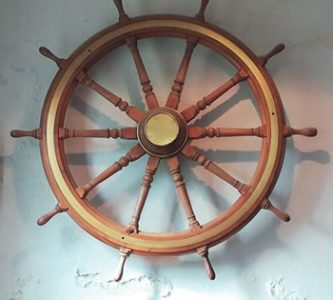 breathing testimony to its heritage and even its churches speak of its sea-going history. Early settlers named the town after Presbyterian Free Church leader Thomas Chalmers and the Presbyterian church of Iona is believed to be the earliest of the town’s holy sites, built in the mid-1800s.
breathing testimony to its heritage and even its churches speak of its sea-going history. Early settlers named the town after Presbyterian Free Church leader Thomas Chalmers and the Presbyterian church of Iona is believed to be the earliest of the town’s holy sites, built in the mid-1800s.
The Catholic church was not too far behind, though the townspeople did not have to wait for the official opening to attend Mass. On the 31 October 1863, the Daily Telegraph published the following: To the Roman Catholics of Port Chalmers – Mass will be celebrated Sunday, 1st of November in the Assembly Rooms by Rev. A. Martin at 11 o’clock being the festival of All Saints. That was the beginning. From then on Mass was celebrated wherever there was an opening, from private homes to the Royal Hotel, the Courthouse or the Town Hall.
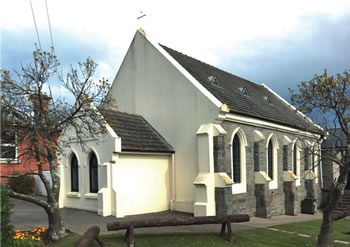
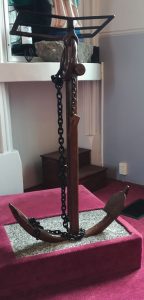 Eight years after that first Mass, a piece of land on the corner of Magnetic and Bernicia Streets was released by the Waste Lands Board. This had been on the condition that the sum of 12 pounds and 10 shillings be paid within a month. Three townsmen, together with Bishop Moran, became the property trustees.
Eight years after that first Mass, a piece of land on the corner of Magnetic and Bernicia Streets was released by the Waste Lands Board. This had been on the condition that the sum of 12 pounds and 10 shillings be paid within a month. Three townsmen, together with Bishop Moran, became the property trustees.
Gaining the land was one thing; realistically financing the building of a church was another. Five years later, when Mr Frank W. Petre submitted plans for his Gothic-style church, the design and proportions were far too ambitious – and expensive – so Bishop Moran reluctantly settled for building just the nave. The revised plan was accepted, Port Chalmers granite was chosen for construction, together with Oamaru stone for the window and door facings. On the 23 September 1877, St Mary Star of the Sea began with Bishop Moran blessing and laying the foundation stone.
Seven months later, on the 12 May 1878, a Pontifical High Mass took place at 11am, celebrated by Bishop Moran, and Fathers Larkin and O’Leary. Catholics from all over the region turned up for the occasion, with a special train being put on from Dunedin. St Joseph’s choir along with a borrowed organ also contributed to this long-awaited day. Future Masses, said the Bishop, would be celebrated twice a month with plans to use the church also as a school. Nine hundred pounds had so far been spent on the church. Twenty years and a further 375 pounds later on 5 June 1898, Bishop Michael Verdon blessed the new additions of the sanctuary and side sacristies.
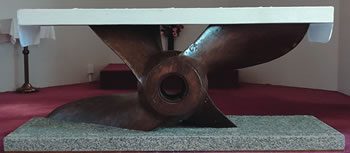
Propellor, and Tabernacle made from an oil lamp, both donated by the Otago Harbour Board
The 20th century inevitably saw more changes. A porch was built in the 1940s and in the 1970s the sanctuary was redesigned,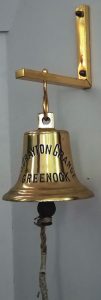 removing the altar rails, pulpit and original altar and adding items that would reflect the town’s maritime heritage. An anchor from the fishing trawler M.S. Bravo is a major feature of the small sanctuary. A Portugese shipbuilder and fisherman, Manuel Gomez began building his boat in 1898 at his home on Stewart Island but died before finishing it. Eventually completed, it was used as a fishing trawler at Port Chalmers for many years before returning to Stewart Island, to end where it had begun.
removing the altar rails, pulpit and original altar and adding items that would reflect the town’s maritime heritage. An anchor from the fishing trawler M.S. Bravo is a major feature of the small sanctuary. A Portugese shipbuilder and fisherman, Manuel Gomez began building his boat in 1898 at his home on Stewart Island but died before finishing it. Eventually completed, it was used as a fishing trawler at Port Chalmers for many years before returning to Stewart Island, to end where it had begun.
In 1970, a propeller was donated by the Otago Harbour Board. It was found in the dockland and it is thought that it may have been from a Norwegian-owned whale chaser. Stewart Island’s whale station often used Port Chalmers shipping services. Otago Harbour Board also gifted the ship’s lamp. The candle and oil-burning lamp is over 100 years old and was converted in 1988 into the church’s Tabernacle.
The bell in the sanctuary bears the inscription S.S. Drayton Grange, Greenock, a ship built in Belfast in 1901. It was used for regular trade between Britain and New Zealand until 1912 when the New Zealand Shipping Company purchased it along with three others. They renamed the ship the S.S. Tyrone. Unfortunately, the following year it ran aground in fog at Rerewahine Point and was completely destroyed.
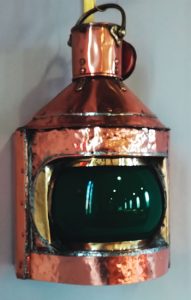
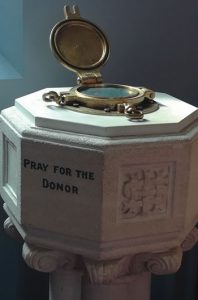 Other points of interest in the church are the porthole used as a cover for the Oamaru stone baptismal font;
Other points of interest in the church are the porthole used as a cover for the Oamaru stone baptismal font;
the crucifix which came from the Philippines was donated by a parishioner in 1984 and the nave windows which were installed in 1988 on the anniversary of the church’s dedication.
Further improvements in the 1980s include placing a new stained glass window in the Blessed Virgin Mary alcove, representing the title of the church, Mary, Star of the Sea.
St Mary’s has certainly stood the test of time. There are reminders everywhere of days gone by, of the ships that visited this port and the people who built the town. The past sits comfortably alongside the present both inside this lovely building and on the streets of Port Chalmers.
While living very much in the 21st century, it has a strong identity with its origins.
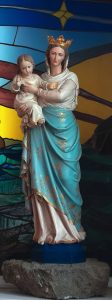 It’s hard to talk about Port Chalmers without mentioning its association with St Mary of the Cross MacKillop. She arrived in the Port in 1898 with two of her Sisters of St Joseph and founded the Josephite order there. St Mary’s School, that had been established in 1882, was renamed St Joseph’s and Mother Mary MacKillop was the first Head of St Joseph’s, living in the town for two months. The Sisters of St Joseph ran the school until 1979 when lay teachers took over.
It’s hard to talk about Port Chalmers without mentioning its association with St Mary of the Cross MacKillop. She arrived in the Port in 1898 with two of her Sisters of St Joseph and founded the Josephite order there. St Mary’s School, that had been established in 1882, was renamed St Joseph’s and Mother Mary MacKillop was the first Head of St Joseph’s, living in the town for two months. The Sisters of St Joseph ran the school until 1979 when lay teachers took over.
 Entries(RSS)
Entries(RSS)